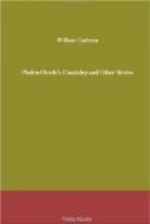Let the reader, in order to understand the situation of the place we are describing, imagine to himself a stupendous cliff overhanging a green glen, into which tumbles a silver stream down a height of two or three hundred feet. At the bottom of this rock, a few yards from the basin formed by the cascade, in a sunless nook, was a well of cool, delicious water. This was the “Holy Well,” out of which issued a slender stream, that joined the rivulet formed by the cascade. On the shrubs which grew out of the crag-cliffs around it, might be seen innumerable rags bleached by the weather out of their original color, small wooden crosses, locks of human hair, buttons, and other substitutes for property; poverty allowing the people to offer it only by fictitious emblems. Lower down in the glen, on the river’s bank, was a smooth green, admirably adapted for the dance, which, notwithstanding the religious rites, is the heart and soul of a Patron.
On that morning a vast influx of persons, male and female, old and young, married and single, crowded eagerly towards the well. Among them might be noticed the blind, the lame, the paralytic, and such as were afflicted with various other diseases; nor were those good men and their wives who had no offspring to be omitted. The mendicant, the pilgrim, the boccagh, together with every other description of impostors, remarkable for attending such places, were the first on the ground, all busy in their respective vocations. The highways, the fields, and the boreens, or bridle-roads, were filled with living streams of people pressing forward to this great scene of fun and religion. The devotees could in general be distinguished from the country folks by their Pharisaical and penitential visages, as well as by their not wearing shoes; for the Stations to such places were formerly made with bare feet: most persons now, however, content themselves with stripping off their shoes and stockings on coming within the precincts of the holy ground. Human beings are not the only description of animals that perform pilgrimages to holy wells and blessed lakes. Cows, horses, and sheep are made to go through their duties, either by way of prevention, or cure, of the diseases incident to them. This is not to be wondered at, when it is known that in their religion every domestic animal has its patron saint, to whom its owner may at any time pray on its behalf. When the crowd was collected, nothing in the shape of an assembly could surpass it in the originality of its appearance. In the glen were constructed a number of tents, where whiskey and refreshments might be had in abundance. Every tent had a fiddler or a piper; many two of them. From the top of the pole that ran up from the roof of each tent, was suspended the symbol by which the owner of it was known by his friends and acquaintances. Here swung a salt herring or a turf; there a shillelah; in a third place a shoe, in a fourth place a whisp of hay, in a fifth an old hat, and so on with the rest.




